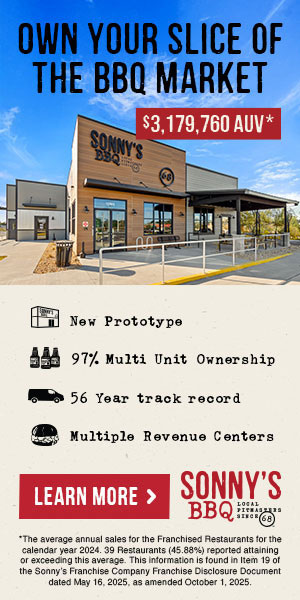Brewing Brand Recognition
(Sunday, January 01, 2006) - There is a saying that in New York: Strangers at cocktail parties ask what you do, while in Los Angeles, they ask whom you know. For quick-serves that want to be famous, the more relevant question might be, "Who drinks your coffee?"
That's how It's A Grind, the Long Beach, California-based coffeehouse chain ended up with a starring role on the critically-acclaimed Showtime Networks hit show Weeds.
In early 2005, Marty Cox, founder and president of It's A Grind, got a call from a prop master at Showtime asking if his company was interested in being a part of a new Showtime series. It turned out that this original contact at Showtime had heard about It's A Grind from her brother-in-law, an enthusiastic patron of the chain's Long Beach stores. Apparently, this brother-in-law's lavish praise of It's A Grind's atmosphere, coffee, and customer service convinced the prop master to contact Cox.
In an age of jaded consumers and ad-zapping TIVOs, getting your product, brand, or store—better yet, all three—on a television show, especially a popular television show can generate great exposure. Weeds actors not only walk in and out of an It's A Grind coffeehouse in the show's opening sequence, star Mary-Louise Parker frequently carries the company's merchandise during her scenes.
In fact, Parker insisted that her character be a coffee fanatic. It's A Grind responded by sending her logo-covered It's A Grind cups, sleeves, drink carriers, t-shirts, and hats.
Thanks to this bounty of branded merchandise, numerous Parker scenes feature her carrying an It's A Grind cup (often the iced-blended mocha version) or using bags of It's A Grind whole-bean coffee.
In addition to exposure on the show itself, It's A Grind got a huge benefit by hitching a ride on the Weeds marketing campaign. Showtime took out full-page ads in Newsweek, People, and TV Guide to promote the show. The ad's featured photo showed Parker holding a cardboard cup with the It's A Grind logo showing plain as day.
Since Cox and his wife, Louise Montgomery, founded It's A Grind back in 1995, the coffeehouse chain has grown exponentially. Cox plans to add another 75–100 stores to his 95-unit chain by the end of 2006. "Weeds is not necessarily fueling that growth, but it has been an added bonus by helping to further validate our brand," Cox says. "We have seen an increase in applications, but we don't know how much we can attribute to the show versus the brand simply growing and gaining exposure in other ways."
In any case, It's A Grind CEO Steve Shoeman knows his company got significant value from being featured on Weeds. "To get this kind of exposure on a national basis would usually cost $1million–$2 million," he says.
The practice of integrating products in television shows goes back to the early days of television, when companies would sponsor entire shows. There was nothing subtle about it. Shows with titles like Texaco Star Theater and the Colgate Comedy Hour ruled the early 1950s ratings game.
Though 30-second commercials later became the dominant mode of television marketing, several factors have contributed to the return to prominence of product placement and branded entertainment.
First, consumers are inundated with advertising messages, not just on television, but also at the movie theater, on the internet, while walking down the street…the list goes on and on. Because of this overload, people have simply begun to tune out. Ad executives ceaselessly discuss the challenge of rising above the "noise" or "clutter" of the advertising landscape.
Second, television itself is changing from a traditional broadcast model to an on-demand system in which consumers can fast-forward and rewind through television shows—and through commercials. One thing TiVo users always mention to their friends with pride is their ability to "zap" commercials. Though digital video recorder market penetration is still low, all signs point to the trend accelerating. And, the consumers who have already switched are of the young and affluent sort that most marketers would love to reach.
In the face of these intersecting trends, marketers have shown renewed interest in product placement and branded entertainment. As it sounds, product placement involves somehow placing a company's product into the environment of a television show or movie.
Branded entertainment can go a bit further in integrating the product into the storyline. One could argue that It's A Grind has reached the level of branded entertainment with Weeds, thanks to the ubiquity with which the company's products appear on the show. The universe the show characters inhabit is filled with It's A Grind products.
Between focusing on customer service and getting involved in the community, It's A Grind has not done much traditional advertising over the years. Stores might send out a bit of direct mail, but the focus is more the experience inside the shops' four walls and getting involved in community causes. "The franchisees don't just hand over a check. That's the easy way. They get personally involved," Cox says. "It's part of our whole marketing strategy.
Based on that low-key marketing approach, it comes as no surprise that It's A Grind franchisees were blown away when the Showtime partnership was announced this past July at the annual franchisee convention.
Chris Jackson is an area developer in Elk Grove, California, who owns two It's A Grind stores with his wife and plans to open more. As he remembers the meeting, Cox took the stage and asked, "Wouldn't it be great if your coffee house brand was on a highly acclaimed television series that featured people walking in and out of an It's A Grind coffee house to begin the show? Wouldn't it be great if the main character was carrying around It's A Grind coffee cups throughout the show?"
"I was pretty excited along with everyone else," Jackson says. He and his wife rushed out and subscribed to Showtime so they could watch every episode and brag about the exposure to their friends. Fortuitously, Weeds ended up becoming a major hit in 2005. A strong cast of actors and a controversial storyline meant that the consumer media was also paying attention to the show, amplifying its visibility—and by association, It's A Grind's—even further.
But has that helped Jackson's business?
Jackson says that the seasonal and cyclical nature of the business make it hard to determine exactly what impact the show has had on sales and customer volume, but he vouchsafes that the show has strengthened brand awareness. "Without a doubt, having It's A Grind featured on a critically-acclaimed and widely-watched show like Weeds has done wonders for reinforcing the brand recognition," Jackson says. For example, a group of local firemen who frequent one of his It's A Grind stores told him they watch the show while waiting for the bell to ring and proudly point to the It's A Grind coffeehouse as their regular hangout.
Neither Jackson nor Cox see any serious risk to appearing on a show like Weeds, a show that deals with issues of drug use. "I wasn't that concerned about it," Jackson says. "I think viewers know that just because the It's A Grind brand is on the show doesn't that the brand or franchise is pushing a certain type of behavior." Cox concurs, arguing that It's A Grind's presence on the show doesn't mean equal an endorsement of characters' behavior. In any case, the point is somewhat moot since neither Cox nor Jackson report having received any negative backlash or comments about the show from customers.
So if It's A Grind is getting loads of free exposure, what is Showtime getting out of the deal. Not cash. Penny Reiss, vice president of product integration at Showtime, says her network does not do "pay-for-play."
So what does the network get out of product placement, if not monetary compensation? Well, imagine that a show has a scene set in a coffeehouse. The production team has two choices—it can create a fake coffeehouse set and fake collateral (bags of coffee, cups, signage, and so forth), or it can make a deal with a real coffeehouse, like It's A Grind. The coffeehouse gets publicity, and the television show saves time and money that it would have otherwise had to spend on set and props.
"That's how a lot of deals start," Reiss says. However, in the future, Showtime will be looking for brands featured on its shows to contribute to fulfilling production needs—helping with marketing needs. "For a long time, we have been a very good place for brands to get free exposure. Now we are hoping to leverage these brands for marketing and production support."
As of late December, Showtime would not comment on whether Weeds would be picked up for another season. A Showtime rep would say only the show was a "huge success" and that the critics loved it. But both Reiss and Cox describe discussions about involving It's A Grind in a second season of Weeds, should one be produced. No doubt, Cox and his franchisees would love the exposure.
But considering Reiss's interest in some sort of quid pro quo, Cox might have to face up to the question: Just how much is Mary-Louise Parker's prime time It's A Grind habit worth?
###
| ADVERTISE | SPONSORED CONTENT |
Franchise News
By Type
- Expansions & Growth
- Financial & Earnings Claims
- Mergers & Acquisitions
- Personnel Changes
- Conferences & Events
- Product Announcements
- Media Coverage
- Strategic Alliances
By Sector
| ADVERTISE | SPONSORED CONTENT |



 The franchise opportunities listed above are not related to or endorsed by Franchising.com or Franchise Update Media Group. We are not engaged in, supporting, or endorsing any specific franchise, business opportunity, company or individual. No statement in this site is to be construed as a recommendation. We encourage prospective franchise buyers to perform extensive due diligence when considering a franchise opportunity.
The franchise opportunities listed above are not related to or endorsed by Franchising.com or Franchise Update Media Group. We are not engaged in, supporting, or endorsing any specific franchise, business opportunity, company or individual. No statement in this site is to be construed as a recommendation. We encourage prospective franchise buyers to perform extensive due diligence when considering a franchise opportunity.